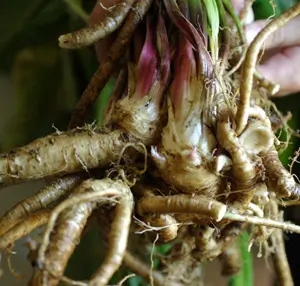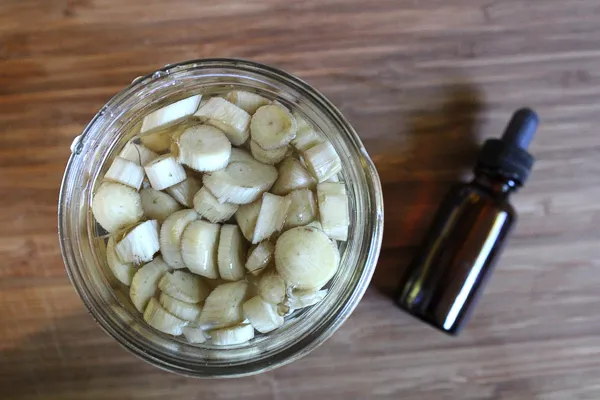Elecampane : a panacea with tonic and antitussive properties
- Herboristerie La Fée des Bois

- Mar 24, 2024
- 6 min read
Updated: Apr 5, 2024
Elecampane (Inula helenium) is a plant of the Asteraceae family, native to Eurasia from Spain to Xinjiang province in western China. It is now naturalized in parts of North America.

A Bit of History
This robust plant can reach heights of over 2.5 metres, and has large, toothed leaves. The stems bear heads of yellow flowers, composed of 50 to 100 ligulate flowers and 100 to 250 tubular flowers. The root is thick and branched and has a bitter, camphorated taste.
In folklore, elecampane is associated with elves. The plant is said to have grown where Helen of Troy's tears fell. The plant was therefore sacred to the ancient Celts, who gave it the name "elfwort".
In medieval Europe, the roots were candied and eaten as sweets. In France and Switzerland, they were used to make absinthe. Nichola Culpeper, a 17th-century herbalist, recommended it for warming cold and windy stomachs, resisting poison, strengthening eyesight and clearing internal blockages.

Cultivation and Harvest
In Quebec, elecampane can occasionally be found growing wild around Montreal and Quebec City, or in the Gaspé Peninsula. It prefers damp places, and is well adapted to our climates, so grows well. Take care to remove dead flower heads at the end of flowering, if you don't want to end up with lots of "baby elecampane" the following season!
It's such a beautiful plant; it's like having perennial sunflowers! The leaves are huge and it produces gorgeous yellow flowers.
The plants take several years to mature. This maturation is necessary to harvest the roots, which are so rich in taste and smell. At La Fée des Bois Apothecary, we harvest them in autumn, putting the plants back in the ground after removing the roots to be processed. Once again, everything is done by hand; no machinery is used at this stage.

Properties
Elecampane is a widely-used plant for the respiratory and immune systems, particularly for ailments involving mucus and coughs. Its stimulating aromas, combined with mucilage, make this plant an excellent expectorant, calming irritation of the respiratory tract while evacuating and drying mucus (mucolytic). It is one of the rare bronchospasmolytic or bronchodilator plants, which means it is widely used in cases of chronic coughs, coughs that won't go away following infections, or infections with a strong cough and mucus. It is also very useful for people suffering from asthma, or who simply have a tendency to get bronchitis easily.
Its high content of essential oils, inulin and other active ingredients make it an outstanding antiviral and antibacterial agent. It can therefore be used during and after infections in cases of chronic bronchitis, sinusitis, influenza, colds, asthma and emphysema-like conditions, making it a plant with a wide range of possible applications.
As it acts as a "regenerating tonic" for the lungs, helping them to strengthen their muscles and thus promoting tissue longevity, it can even be taken as a preventive measure, but only for short periods or in very small quantities, as this is a strong and powerful plant.
A great digestive tonic, it is a detoxifying plant that supports the work of the liver and has a beneficial effect on the stomach, intestines and colon. Its high content of sesquiterpene lactones (notably alantolactone and santamarin), molecules with a bitter taste, makes it a bitter tonic that will even act as a vermifuge and antifungal, a great friend to bring along on a trip as a preventive measure or on return as a preventive treatment.
The digestive system also benefits greatly from its high inulin content (30 to 40%), a prebiotic active ingredient that contributes to the health of our microbiota (and therefore to our immunity!). Inulin may have antitumoral, antimicrobial, hypolipidemic and hypoglycemic properties. Inulin also promotes mineral absorption and balance, thanks to its action on our intestinal flora. The science surrounding the microbiota has been in full swing in recent years, and research in this area is still in its infancy!
The famous inulin fiber also helps maintain an ideal, optimal density for the bone matrix, thus limiting the risk of osteoporosis.
Elecampane is a tonic and diaphoretic plant, and also has an affinity with the urinary system. Its diuretic effect can therefore have an impact on urinary tract infections, water retention and even nephritis.
Be careful, however : as elecampane is a drying plant, it's important to keep well hydrated when taking it (as with many plants), and to adequately assess long-term intake.
Elecampane In the Kitchen
Elecampane produces a large, highly aromatic rhizome. It can be grated to flavour fruit salads, cakes, desserts or liqueurs, ideally after blanching to remove some of its bitter, camphor-like flavour! In fact, elecampane root can be used in place of ginger, but you shouldn't expect exactly the same taste. It can certainly be used to make syrups and lozenges, its high camphor content being much appreciated for sore throats. It is also used to make bitter digestives.
Contraindications/Precautions
Elecampane stimulates uterine contractions, making it unsuitable for pregnant women. It is also not recommended for nursing mothers.
Because of its inulin content, elecampane can interfere with blood sugar levels, so is beneficial for diabetics, but take care if taking medication. Must be closely monitored for readjustment.
At excessive doses (1 gram per herbal tea, 3 to 4 times a day), elecampane can cause cramps. It is a strong plant to be taken in reasonable doses over the short to medium term.
People allergic to certain plants in the Asteraceae family (matricaria, chamomile, echinacea, etc.) should be cautious with elecampane, as cross-reactivity with these plants is common.
Uses and Dosage
Elecampane root contains essential oils that will be partially lost in a decoction, so don't hesitate to opt for a cold infusion, mother tincture or glycerol to benefit from its aromatic properties. Always make your infusions and decoctions with a lid, and never boil, to preserve the maximum amount of essential oils.
Cold infusion : infuse 2 to 10 grams of dried root in 1 liter of cold water for at least 4 to 6 hours. Warm slightly, filter and drink during the day.
Decoction : simmer 2 to 10 grams of dried root for 45 minutes. Drink during the day.
Mother tincture : 1 ml, 4 to 6 times a day for treatment of an acute respiratory infection, or 1 ml, 2 to 3 times a day as a medium-term treatment for the lungs.
Glycerate : 1 to 2 ml, 4 to 6 times a day for treatment of acute respiratory infections, or 1 to 2 ml, 2 to 3 times a day for medium-term treatment of the lungs.
Elecampane is a strong plant to be taken in reasonable doses, over the short or medium term and never over the long term.
Our Herbal Products Using Elecampane
Our famous Elderberry Syrup contains elecampane, of course! An immunity-boosting syrup for the whole family, made with elderberries, spilanthes, mullein, marshmallow, mint, elecampane and honey. A great formula for fighting viral infections and boosting immunity and bacterial flora. A highly effective remedy for coughs, colds, flu and other respiratory infections. It relieves nasal discharge and congestion, sore throat, headache and fever, aches and chills, excess phlegm and sneezing. Details at https://www.herboristerielafeedesbois.com/en/product-page/sirop-sureau
Our Bitter Digestive Tonic is a must for a healthier gut! It helps eliminate waste and assimilate nutrients, making it an excellent general tonic. It regulates liver function, helps relieve bloating, chronic gas, indigestion and gallbladder congestion, and promotes waste elimination. Rich in inulin (a prebiotic), which supports the intestinal microbiota, it helps balance blood sugar levels and plays an important role in preventing osteoporosis. It's a product that helps maintain overall health. More details at https://www.herboristerielafeedesbois.com/en/product-page/tonique-digestif-amer
We also have Histamina single-extract tincture, which contains elecampane root as the first ingredient, as well as ground ivy, nettle, mullein, goldenrod, hawthorn leaf and fruit and cayenne. All plants are farm-fresh. An excellent formula that modulates the immune system through its antihistaminic action, and helps alleviate symptoms related to allergic and inflammatory reactions of all kinds. Use for prevention or in emergency situations. To order: https://www.herboristerielafeedesbois.com/en/product-page/teinture-histamina
And finally, coming to Herboristerie La Fée des Bois, the Elecampane single-extract tincture! Stay tuned!
You can also find this beautiful plant at our annual plant sale at the farm, May 4-5, 11-12 and 18-19, 2024.














